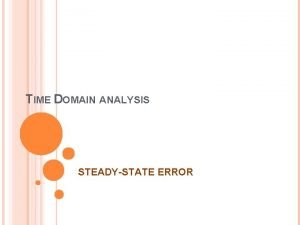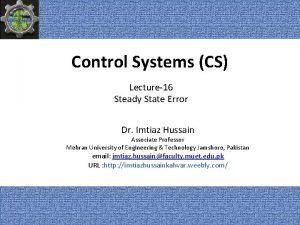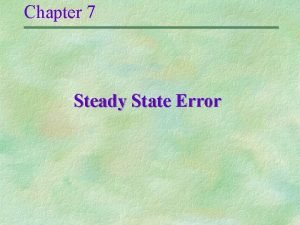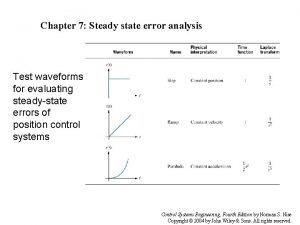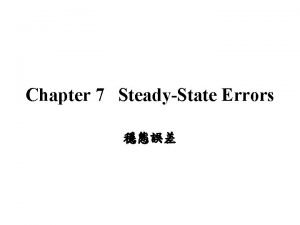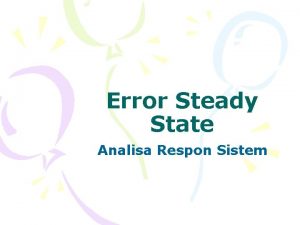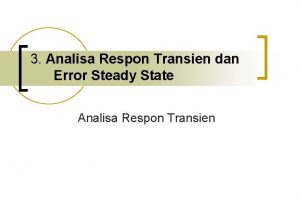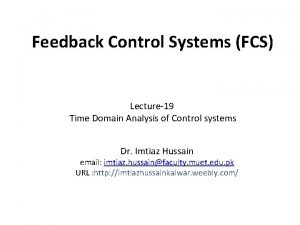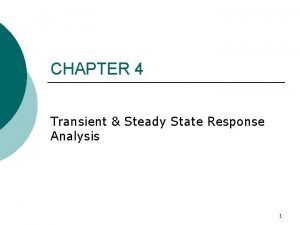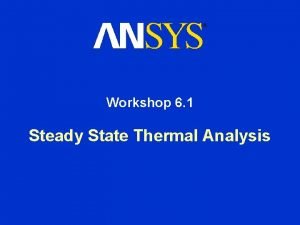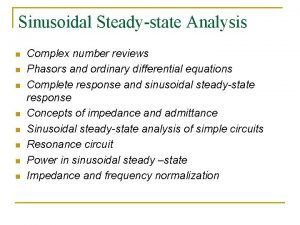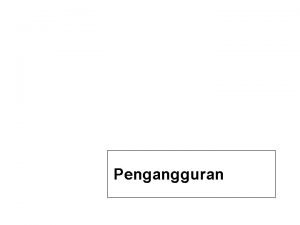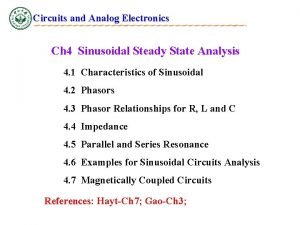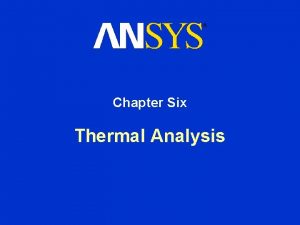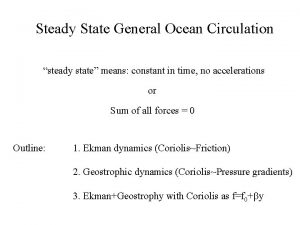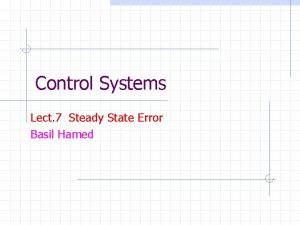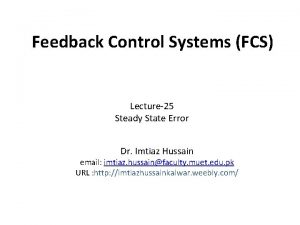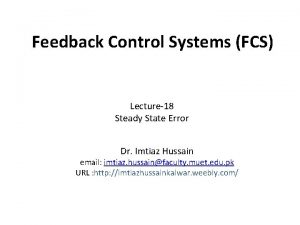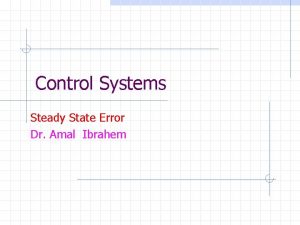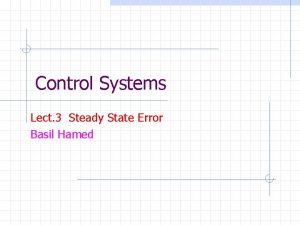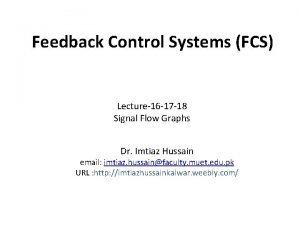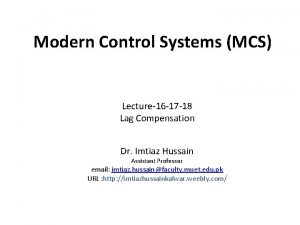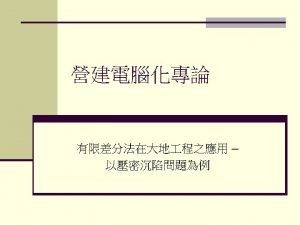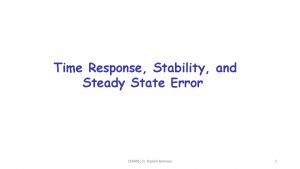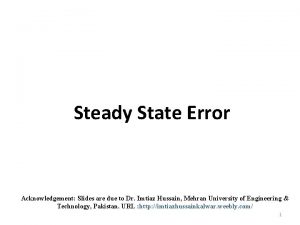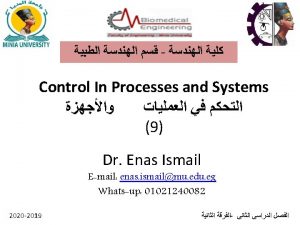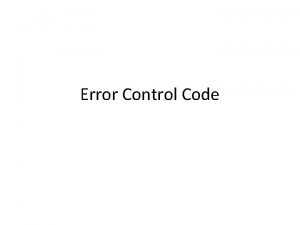Control Systems CS Lecture16 Steady State Error Dr





















- Slides: 21

Control Systems (CS) Lecture-16 Steady State Error Dr. Imtiaz Hussain Associate Professor Mehran University of Engineering & Technology Jamshoro, Pakistan email: imtiaz. hussain@faculty. muet. edu. pk URL : http: //imtiazhussainkalwar. weebly. com/ 1

Introduction • Any physical control system inherently suffers steady-state error in response to certain types of inputs. • A system may have no steady-state error to a step input, but the same system may exhibit nonzero steady-state error to a ramp input. • Whether a given system will exhibit steady-state error for a given type of input depends on the type of open-loop transfer function of the system.

Classification of Control Systems • Control systems may be classified according to their ability to follow step inputs, ramp inputs, parabolic inputs, and so on. • The magnitudes of the steady-state errors due to these individual inputs are indicative of the goodness of the system.

Classification of Control Systems • Consider the unity-feedback control system with the following open-loop transfer function • It involves the term s. N in the denominator, representing N poles at the origin. • A system is called type 0, type 1, type 2, . . . , if N=0, N=1, N=2, . . . , respectively.

Classification of Control Systems • As the type number is increased, accuracy is improved. • However, increasing the type aggravates the stability problem. number • A compromise between steady-state accuracy and relative stability is always necessary.

Steady State Error of Unity Feedback Systems • Consider the system shown in following figure. • The closed-loop transfer function is

Steady State Error of Unity Feedback Systems • The transfer function between the error signal E(s) and the input signal R(s) is • The final-value theorem provides a convenient way to find the steady-state performance of a stable system. • Since E(s) is • The steady state error is

Static Error Constants • The static error constants are figures of merit of control systems. The higher the constants, the smaller the steady-state error. • In a given system, the output may be the position, velocity, pressure, temperature, or the like. • Therefore, in what follows, we shall call the output “position, ” the rate of change of the output “velocity, ” and so on. • This means that in a temperature control system “position” represents the output temperature, “velocity” represents the rate of change of the output temperature, and so on.

Static Position Error Constant (Kp) • The steady-state error of the system for a unit-step input is • The static position error constant Kp is defined by • Thus, the steady-state error in terms of the static position error constant Kp is given by

Static Position Error Constant (Kp) • For a Type 0 system • For Type 1 or higher systems • For a unit step input the steady state error ess is

Static Velocity Error Constant (Kv) • The steady-state error of the system for a unit-ramp input is • The static position error constant Kv is defined by • Thus, the steady-state error in terms of the static velocity error constant Kv is given by

Static Velocity Error Constant (Kv) • For a Type 0 system • For Type 1 systems • For type 2 or higher systems

Static Velocity Error Constant (Kv) • For a ramp input the steady state error ess is

Static Acceleration Error Constant (Ka) • The steady-state error of the system for parabolic input is • The static acceleration error constant Ka is defined by • Thus, the steady-state error in terms of the static acceleration error constant Ka is given by

Static Acceleration Error Constant (Ka) • For a Type 0 system • For Type 1 systems • For type 2 systems • For type 3 or higher systems

Static Acceleration Error Constant (Ka) • For a parabolic input the steady state error ess is

Summary

Example#1 • For the system shown in figure below evaluate the static error constants and find the expected steady state errors for the standard step, ramp and parabolic inputs. R(S) - C(S)

Example#1 (evaluation of Static Error Constants)

Example#1 (Steady Sate Errors)

To download this lecture visit http: //imtiazhussainkalwar. weebly. com/ END OF LECTURE-16
 In time domain analysis, finite steady state error is
In time domain analysis, finite steady state error is Find the position error constant, kp
Find the position error constant, kp Steady state error solved problems
Steady state error solved problems Steady state error table
Steady state error table Steadystate error
Steadystate error Error steady state adalah
Error steady state adalah Respon transien orde 1
Respon transien orde 1 The impulse signal imitate the
The impulse signal imitate the Steady state response
Steady state response Data link control
Data link control Control flow errors
Control flow errors Ansys steady state thermal tutorial
Ansys steady state thermal tutorial Sinusoidal steady state
Sinusoidal steady state Pengangguran alamiah adalah
Pengangguran alamiah adalah Mitokondre
Mitokondre Nicole menten
Nicole menten What is steady flow process in thermodynamics
What is steady flow process in thermodynamics In a normal operations/steady state eoc activation level
In a normal operations/steady state eoc activation level Sinusoidal steady state analysis of coupled circuits
Sinusoidal steady state analysis of coupled circuits Steady state vs equilibrium
Steady state vs equilibrium What is steady-state thermal analysis?
What is steady-state thermal analysis? Michaelis menten steady state
Michaelis menten steady state
